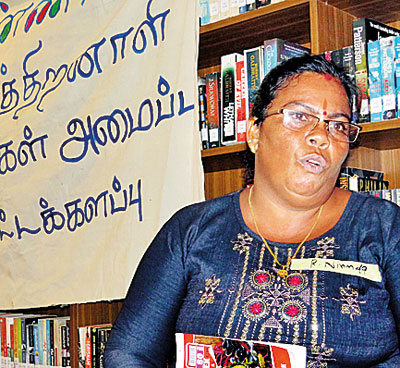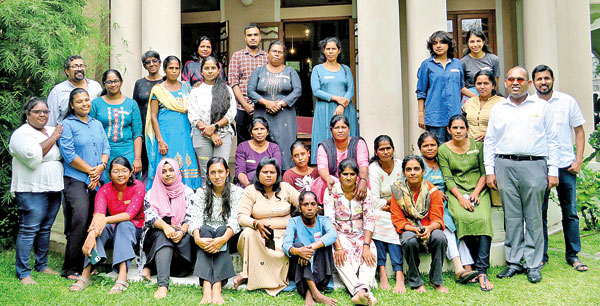News
Underfunded services pile on indignities for disabled people in the North and East
View(s):By Mimi Alphonsus
In the war-affected North and East, people with disabilities struggle to cope as NGOs exit and archaic state systems suffer from underfunding.
R. Nirmala from Batticaloa has lived with disability since 1997, when shell pieces got embedded in her head, arm and waist. She suffered partial paralysis and could not speak for two years. After medication and therapy, she can talk and walk but endures debilitating pain.
War-related disabilities are different because many, like Ms. Nirmala, are invisible. This means sufferers must prove their disability to access services. From the Government’s Rs. 5,000 disability allowance to medical care to special licensing services for motor vehicles, they are frequently questioned by officials and forced to showcase their disability in humiliating settings.

Nirmala: All we want is dignity and rights
“All we want is dignity and rights,” said Ms. Nirmala, who is part of Vannam, a Batticaloa-based women’s disability group that advocates for disability rights. At an awareness programme this month, one of the facilities they requested was a disability ID card.
“These ID cards exist for war veterans and grant them access to free medicine and transport passes,” said Sarala Emmanuel, an activist. “So such a system is possible for everyone living with disabilities.”
Vannam also asked for improved accessibility to government buildings and public transport, expansion of the state’s Rs. 5,000 disability allowance, and training of healthcare staff and jobs.
In the North and East, both ex-LTTE combatants and civilians struggle with war-related disabilities. Unlike those born with them, those who become disabled after an injury remember a different life. Emmanuel explains that it can be difficult to cope with the change. Married women are often abandoned by their husbands after the disability, rendering them the sole breadwinners of their families.
“Many people did not complete their education and do not have family members who can support them as they have died or disappeared,” said a disability advocate from Vavuniya. “So the support systems that might exist for those with disabilities elsewhere are not available to them.”
Economic self-sufficiency is crucial. However, since employers overlook them, jobs are scarce, and many live in extreme poverty.
Getting government support is difficult. According to Jayamali Wickramaarachchi, Chairperson of the National Secretariat for Persons with Disabilities, 72,000 people are on disability allowance, but 58,000 more countrywide are on the waiting list.
“When we try to get the Rs. 5,000, we are told to wait till someone receiving it dies,” explained a woman who also asked not to be named. “What a horrible thing to wish for.”
The disability allowance is based on data from the 2012 census. The secretariat cannot carry out new research as it does not have enough staff, Ms. Wickramaarachchi said. Last year, 22,731 people in the North and East received the monetary allowance. That is 31% of the total beneficiaries in the country.
“The Government calculates and gives us limited money to disburse,” said a local council official in Mullaitivu. “We have been pressuring them to fill the gaps for some time now.”
Additionally, the disability allowance is reserved for those with a monthly family income below Rs. 6,000. But those with disabilities have heavy medical expenses due to inadequacies in the hospital system.
One woman from Batticaloa uses a prosthetic leg. But the gel socks she needs cost nearly Rs. 43,000. “The hospital tells me to buy it outside, but I cannot afford such an amount every six months,” she said. “So I somehow try and make the socks I have last longer.”
While cutting corners like this is common, it can cause secondary disabilities, warns staff at CAMID, a disability NGO: “When incorrect equipment is used or when the fixing is done haphazardly, there can be injuries to other parts of the body over time. But many are forced to manage with broken or old devices because the Government hasn’t budgeted enough for raw materials and equipment.”
For many years, international NGOs like Handicap International (recently renamed Humanity and Inclusion) and Venpura provided these expensive prosthetics for free. But many of these INGOs have downsized operations in Sri Lanka and handed over their work to hospitals and government offices.
Jaffna Jaipur Centre, a local organisation, finds times difficult. “Earlier, many international NGOs subsidised our prosthetics,” said Dr. J. Ganeshamoorthy, the chairman. “But since many of them left after the war, the burden on us has increased. The Government provides money for those below the poverty line. For everyone else, it’s very difficult to procure the funding.”

With limited funds and little support, activists face an uphill task in their fight for the rights of disabled people. Pix by Dilushi Wijesinghe
The secretariat plans to introduce a disability ID card system in 2024 and also hopes to expand its existing programmes, Ms. Wickramaarachchi said. But its budget had been just Rs. 34 million this year to cover its housing, education, and medical assistance programmes, among other things. To cover the 1.6 million people living with disabilities in Sri Lanka, that allocation will need a serious boost.
The best way to say that you found the home of your dreams is by finding it on Hitad.lk. We have listings for apartments for sale or rent in Sri Lanka, no matter what locale you're looking for! Whether you live in Colombo, Galle, Kandy, Matara, Jaffna and more - we've got them all!

